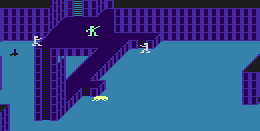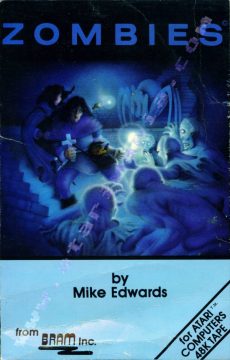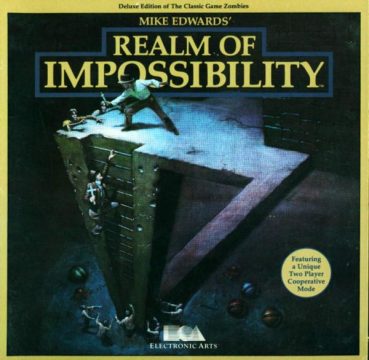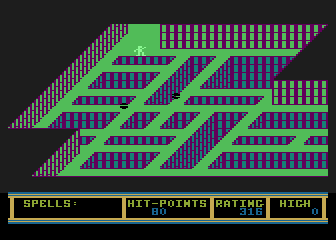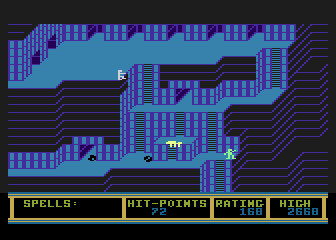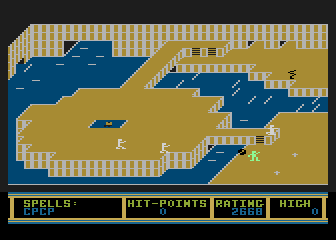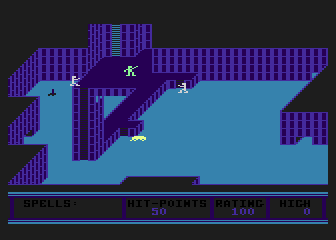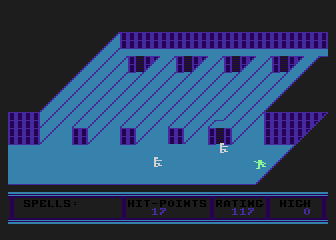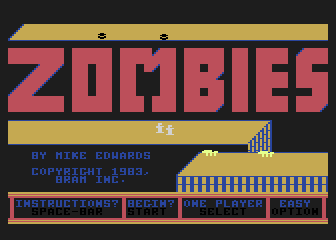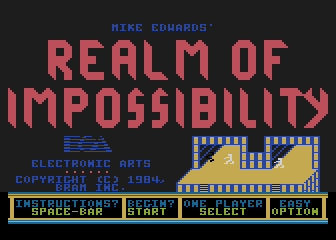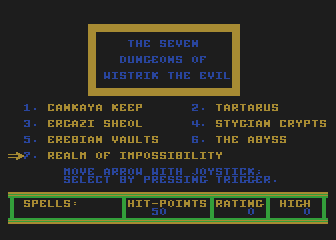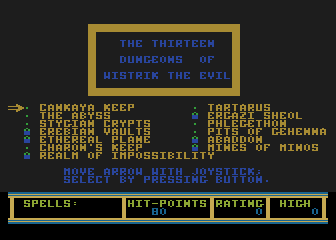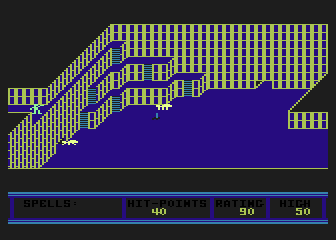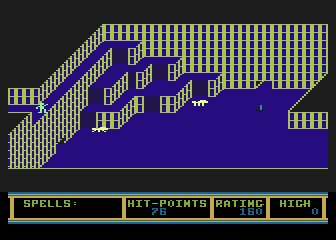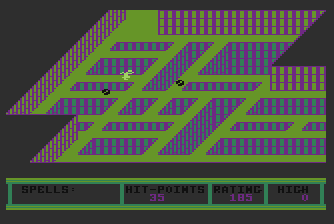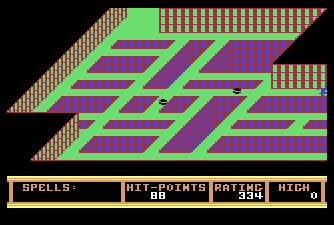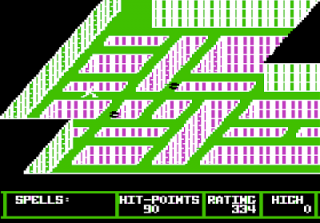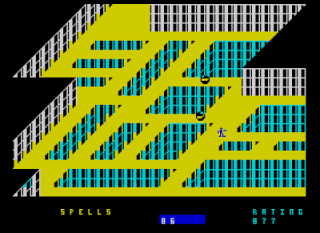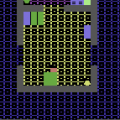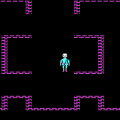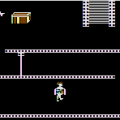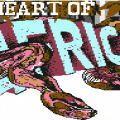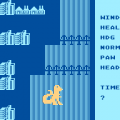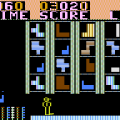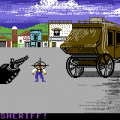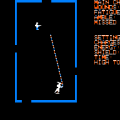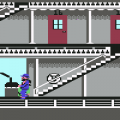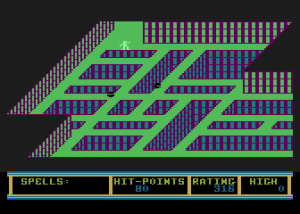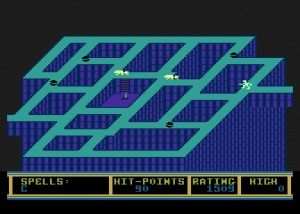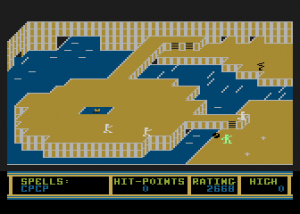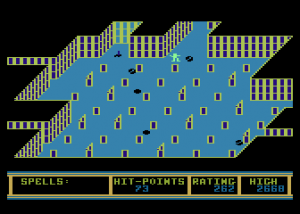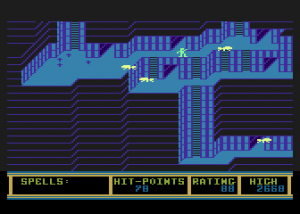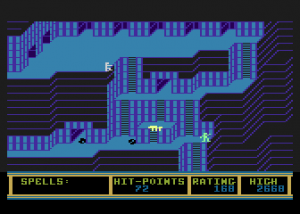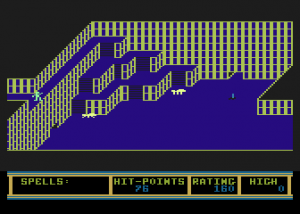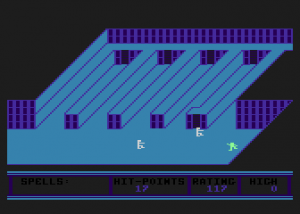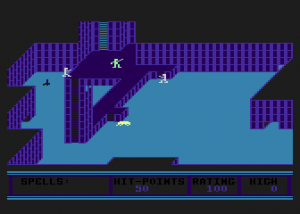Realm of Impossibility is one of those classic computer games that manages to do a lot with very little. Your goal, as a little stick figure man, is to run through an assortment of dungeons, avoid the monsters within, find the treasure at the end, and then return to the starting point. You don’t have a direct method of attack, but instead defend yourself by dropping crosses, which act as barriers between you and the enemies. Having seemingly limitless pockets, you can drop huge swathes of them, though they disappear after a few seconds. Throughout the caverns, you can also find a number of single use magic spells, which can confuse the enemies, turn yourself momentarily invincible, or freeze everything on the screen. Two players can also play at the same time. According to the packaging, it was conceived by developer Mike Edwards as a game he could play with his son.
The view is presented from a slightly skewed perspective, though it’s not quite the 3/4 view of most other isometric games. You move left and right normally, but move upwards and downwards at an angle. It gives the landscapes some depth and mostly avoids the directional confusion that otherwise comes with this type of perspective. It does feel a little odd, though, that running horizontally is much faster than running vertically. Plus, there are many narrow ledges, and it’s easy to get stuck along them, but at least there aren’t any pits to fall down or anything. Many screens have multiple levels, connected via ladders, though there’s no platforming of any kind, just running and climbing. The enemies – spiders, orbs, zombies, snakes – aren’t particularly smart, as they mostly just make a beeline towards the closest player, but their dumbness also makes them get caught up along the walls and ladders, occasionally making them impossible to avoid if you get stuck. While your life meter is generous, there’s no invincibility time when taking damage. So, you can just run past and tap an enemy and only lose a point or two, but if you get too close to them for too long, you’ll find yourself dead in a matter of seconds.
The opening instructions actually gives something to the game’s story, rather than just sticking it all in the manual, detailing your crusade through the dungeons of the evil cleric Wistrik. Indeed, the game really tries its hardest to make it feel like a role-playing game even though it’s pretty much a straight action game. The levels all have incredibly cool sounding titles like “Ergazi Sheoul”, “Erebian Vaults”, “Stygian Crypts”, “Ethereal Plane” and “Pits of Gehenna”. Of course, visually there’s not really much to differentiate most of the levels except for the color scheme, but it’s a cool touch.
This game was originally released under the name Zombies from Atari 8-bit computers, developed by Mike Edwards and published by his company, BRAM. It was then picked up by Electronic Arts and was expanded with nearly double the amount of levels, plus it was given wider distribution on other platforms. Zombies is a fairly generic name, so instead it takes on the name of one of the game’s stages, “Realm of Impossibility”. This is because some of the levels use various visual tricks to present the dungeons as sort of a simple M. C. Escher painting you can run around in. It’s nothing complicated given the hardware, but it’s an impressive effect nonetheless, and adds a slight puzzle solving element in figuring out what you can walk on. Indeed, the visuals are simple, but the eerie, quick movements of the enemies against the stark backgrounds lends to regular sense of panic. There’s no music in game, just the shuffling of your steps, the sounds of dropped crosses, and the shrieking noise when taking damage, along with a “level entry” ditty and other minor sound effects. Taken together, they create an effective atmosphere for an exciting action game, and one of the classics of the 8-bit computer era.
Zombies only has seven stages, that you can conquer in any order. Realm of Impossibility has thirteen, though you need to beat seven specific ones in order to get their keys, in order to unlock the second half of the stages. You only get one life, though, and if you die, you’ll need to start from scratch. The re-release, perhaps owing to its longer length and responding to some feedback of the original version, is a bit easier, with slightly re-designed levels that widen some of the narrower areas, as well as granting more hit points. It also has a new title theme.
As far as the ports, the Atari 8-bit and Commodore 64 versions are basically identical, outside of different music on the title screen and some color palette changes. The Apple II version is more garish looking and a little slower, plus the white color of the main sprite makes it blend in with the backgrounds, but is still reasonably playable. On the other hand, the ZX Spectrum version, released by Ariolasoft, is a wreck, with awful looking sprites, terrible color schemes with a concentration on yellows and greens, and exceedingly choppy and slow movement.
Links:
Screenshot Comparisons
